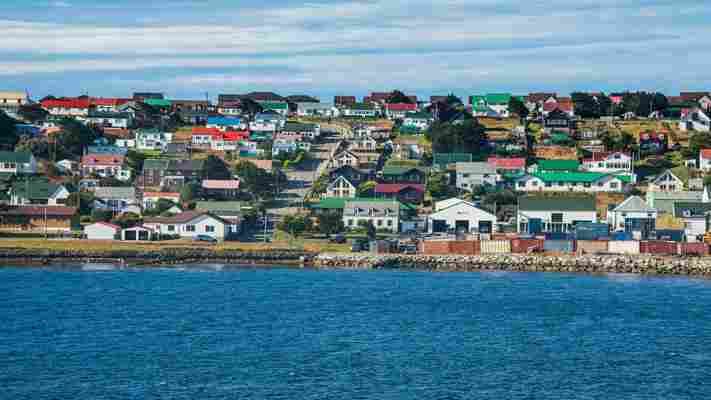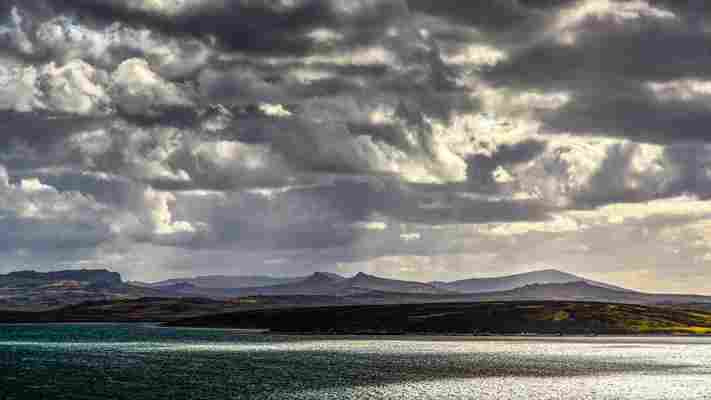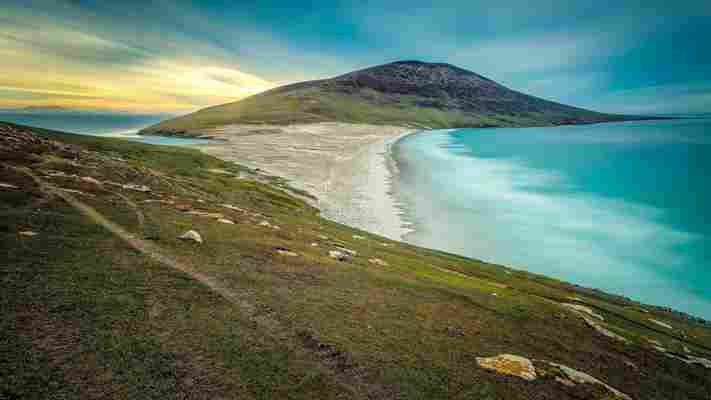This story is adapted from Feeding the Falklands , reported by Gerard Baker and produced by Chris Ledgard. Listen to more episodes of The Food Programme from BBC Radio 4 here .

Surrounded by the South Atlantic and separated from Great Britain by some 13,000km, the Falkland Islands are a series of rugged, windswept islands located between Patagonia and South Georgia . This self-governing archipelago is made up of two main islands and almost 800 smaller ones, and it remains the subject of a sovereignty dispute between the UK and Argentina, who waged a brief war here in 1982.
Only 3,480 hardy residents (known as “Kelpers” because of the large seaweed beds surrounding the islands) live on the Falklands, but they have plenty of company: more than a million penguins and around half a million sheep. The islands’ sub-Antarctic waters are also teeming with squid and fish, but fresh fruit and vegetables are very hard to come by. And when it does arrive, almost all of it by sea, it’s not cheap – a pineapple, for example, can cost up to £15.

Separated from its British motherland by some 13,000km, the Falkland Islands are a remote, self-governing archipelago in the South Atlantic (Credit: Neil Bussey/Getty Images)
When you live somewhere this remote and have faced political uncertainty, food self-sufficiency might feel particularly important, but eating a varied diet can be tough in this rough landscape. Back in the mid-1980s, the economy was heavily dependent on the export of wool, and it’s still common for a courgette to cost more than half a leg of lamb. As a result, islanders historically haven’t eaten anything much more exotic than mutton stew.
This far-flung British island is starting to become something of a laboratory for food sustainability
Yet, recent efforts have been taking place to change that, and as islanders increasingly grow their own produce and champion food self-sufficiency, this far-flung British island is starting to become something of a laboratory for food sustainability.
Suzan Pole-Evans and her family own and farm Saunders Island , the fourth-largest of the Falkland Islands. They are the island’s only permanent residents, but in the summertime, the population swells as tourists come to hike its rocky peaks, climb its sandy dunes and look for penguins and elephant seals.
“People say, ‘How can you live in such isolation?’. I [say] the whole world comes to me in the summer,” Pole-Evans said.

The Pole-Evans family run a sheep farm on Saunders Island and are the island's only permanent residents (Credit: David Merron/Getty Images)
Tourism is a relatively new venture for the Pole-Evans family, and the income supports their sheep farm. Owning your own island may seem idyllic but if you live somewhere this remote, you have to be able to feed yourself, and this is a tough landscape to farm.
You could be really lazy and [not] have a garden, but it does cost a fair bit to get them [from] the aeroplane.
“After being in the UK in 2015 and seeing the fields with grass to their knees… here, [the sheep are] lucky if there’s grass to their ankles,” Pole-Evans said. “It’s too expensive to get fertiliser, but we’ve got a lot of kelp that washes up on the beach. We’ve got a fertiliser spreader coming from the UK, so we’re going to spread all these fields with kelp.”
In addition to sheep, the Pole-Evans family grows crops and raises enough cows for milk and meat to feed themselves, but they don’t sell any of it.
“We grow our own gardens because we always like to have fresh vegetables. I can never grow enough potatoes, but we just grow up enough to give us a nice taste,” Pole-Evans said. “You can buy frozen vegetables. You could be really lazy and [not] have a garden, but it does cost a fair bit to get them [from] the aeroplane. What I’d ideally like to do is try and sell lots of beef, but it’s so difficult to ship them off.”
This has been a theme of food on the Falklands for generations. There is the challenge of exporting food out, and importing what people need at a sensible price. A visit to a supermarket in Stanley, the Falklands’ capital, shows just how eye-watering these heavy tariffs can be: half a pound of shallots costs £3.99; half a white cabbage costs £6.18 and 2lbs of courgettes cost £7.23.
The Falklands are home to about 3,480 people and half a million sheep (Credit: SteveAllenPhoto/Getty Images)
There’s no shortage of farmland in the Falklands. There are more than 80 farms here, with the average size around 25,000 acres. But the soil is thin and acidic, which is why Kelpers have historically been so reliant on imported vegetables year-round. The quality of grazing is also quite poor. As one farmer remarked, “In the UK, you talk about number of animals per acre, but here, it’s acres per animal.”
You can turn mutton into every meat going, if you feel so inclined
Long-time residents, however, remember the not-so-distant times when purchasing vegetables wasn’t even possible, and when self-sufficiency meant something pretty basic.
“We had as much meat as you could want and more, but you didn’t have much else,” said resident Val Ellis. “You had to make do and mend. Sometimes you could buy army food and we used to make things out of army food that were never intended for the squad… you can turn mutton into every meat going, if you feel so inclined.”
“We ate a huge amount of meat,” agreed Sally Blake, a fourth-generation Falkland Island farmer. “A very ordinary breakfast would have been two or three mutton chops with eggs and fried bread.”
Lorraine McGill has clear memories growing up farming in the 1950s on Carcass Island, an hour’s flight north-west of Stanley. “It was mutton 3-6-5,” she said. She and her family also made bread cakes; preserved and pickled hen, penguin and goose eggs; and grew “everything and anything that we [could] grow – root vegetables and all the brassicas and potatoes and carrots”.
For generations, residents have collected and pickled penguin eggs in the Falklands (Credit: Masha Rasputina/Getty Images)
Of course, you can’t grow everything. Most fruit, for example, has to be brought in from South America and it’s not cheap. “When they say [eat] your ‘five a day’, they don’t live in the Falkands,” joked Ellis, pointing to some bananas she’d purchased that morning for £11.34.
Today, family vegetable plots in Stanley are slowly vanishing as more land is devoted to housing. The demand for homes comes not only from new generations of locals, but also from oil workers coming to explore the waters around the islands. Growing food to feed all those people is no easy task, and more and more islanders are resorting to polytunnels to protect their crops from the Falkland winds.
One of them is Tim Miller, whose two heated hydroponic greenhouses and 44 pesticide-free polytunnels at Stanley Growers were dubbed the “Falklands’ most productive half acre and vegans’ organic dream” by local media .
Traditionally, most Falklands families would have a small plot to grow their own vegetables (Credit: Rafael Wollmann/Getty Images)
“Prior to this, there wasn’t any sort of commercial vegetable growing really going on in the Falklands because the population was so small it didn’t warrant it,” Miller said. “But it’s one of the things that was given a kick-start with the increasing population and, of course, the arrival of a permanent British defence garrison. That also meant there was an extra couple of thousand mouths to feed.”
You may also be interested in: • An abandoned British island reclaimed by nature • The tiny 'country' between England and Scotland • Unst: a real life treasure island
In a typical season, Stanley Growers produces about 20 tons of tomatoes, eight tons of cucumbers, eight tons of peppers and 75,000 heads of lettuce. In addition to being able to supply local supermarkets without the heavy import tariffs, the company also supplies fresh produce to passing cruise ships, hotels and restaurants.
Interestingly, Stanley Growers is also the islands’ main importer of produce, flying in an average of 20-30 tons per month of refrigerated produce from London, Santiago and Montevideo. According to Miller, because of the high costs of their relatively small-scale greenhouse-growing operation (their annual electric and water bill is nearly £50,000 a year), it’s actually cheaper to import certain foods from Europe and South America than it is to grow them.
As more people relocate to the Falklands' capital, Stanley, vegetable plots are disappearing (Credit: Westend61/Getty Images)
As more Kelpers build polytunnels to help grow their own gardens, the meat and fish that the islands have in abundance has remained much cheaper to purchase than in the UK – half a leg of lamb, for instance, may cost just £7. Yet, according to Mike Summers, a former member of the islands’ legislative assembly, the lamb, fish and squid the Falklands export to wealthy European markets are central to the Falklands’ self-sufficiency.
We have way more fish than anybody in the Falklands could ever imagine eating
“Food of itself is not a problem. We have way more fish than anybody in the Falklands could ever imagine eating. We have plenty of meat, people grow their own vegetables, beyond that, most other foodstuffs are imported,” he said. “The key issue for us is maintaining suitable communications with the outside world so we can trade out our food surpluses and bring in the things that are not produced here."
While Falklands lamb is a fairly common sight in British supermarkets, Summer says the islands’ biggest food export is squid.
Ships from around the world come to the Falklands to trawl for squid, one of the archipelago's most important exports (Credit: Westend61/Getty Images)
“The [ships] that you can see in the harbour are from Taiwan or Korea. They will catch somewhere between nothing and 100,000 tons of squid. It’s a huge amount,” he said. “There’s another squid fishery, which operates to the east of the Falklands, which is for calamari squid. It’s virtually all imported into Europe, mostly through Spain. In fact, the Falklands has something like 60% of the European supply of that type of calamari. So, when you’re sitting on the beach in the south of France eating squid, there’s a fair chance it came from the Falklands.”
Summer is quick to point out that conservation and sustainability are “absolutely crucial” in managing the islands’ commercial fishing operations – which is responsible for more than 50% of its economy – as well as its growing agricultural yields.
Today, most islanders agree that the quality and variety of food available in the Falklands has come a very long way, and the menu at Malvina House , one of the island’s leading restaurants, reflects these changes. Its menu brings together local Falkland ingredients and imported staples to offer dishes like “Middle Eastern” local lamb shoulder with sautéed chickpeas, a reindeer burger and salted squid chilli.
In recent years, the variety of food available in supermarkets and restaurants has increased greatly in Stanley (Credit: anjci/Getty Images)
“I have to be honest, [when I first came to the Falklands], everybody unfairly said, ‘be prepared for mutton and spuds’,” and I’m aware that was the case, but it already was developing,” said the restaurant’s recent head chef, Matt Clark, who is now back in London. “The (now-closed) Falklands Brasserie was open and doing very well and was very stylish and had produced a book.”
It’s more expensive to import chicken food from the UK than it is to buy chicken from Chile.
Nearby, The Waterfront Kitchen Cafe in Stanley serves plenty of prime Falklands Angus and Hereford steaks and local upland goose pâté, but it also offers homemade pad Thai, South African-style peri-peri chicken and crispy duck spring rolls. And within a five-minute drive of one another, there are now two places serving stone-baked pizza.
According to Clark, a few farmers have started raising chickens and pigs on a small scale, but by and large, all the islands’ bacon and sausage still have to come from 13,000km away in the UK.
"I was talking to a farmer the other day and they said, ‘Well, we’d love to keep more chickens, but actually it’s more expensive to import chicken food from the UK than it is to buy chicken from Chile.'"
Perhaps in the future, Kelpers will develop innovative ways to raise birds in protected polytunnels. Until then, expect to pay more at Malvina House when ordering the pan-seared chicken than the prawns, lamb chops or fish.
Join more than three million BBC Travel fans by liking us on Facebook , or follow us on Twitter and Instagram .
If you liked this story, sign up for the weekly bbc.com features newsletter called "The Essential List". A handpicked selection of stories from BBC Future, Culture, Worklife and Travel, delivered to your inbox every Friday.
